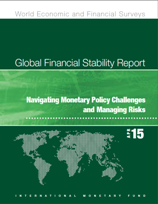Global Financial Stability Report
Navigating Monetary Policy Challenges and Managing Risks
April 2015
Disclaimer: As used in this volume the term “country” does not in all cases refer to a territorial entity that is a state as understood by international law and practice. As used here, the term also covers some territorial entities that are not states but for which statistical data are maintained on a separate and independent basis.

Global financial stability risks have risen since October. Chapter 1 finds that these risks have also been pivoting away from banks to shadow banks, from solvency to market liquidity risks, and from advanced economies to emerging markets. In advanced economies, the key challenge is to enhance the traction of accommodative monetary policies, ensure a smooth normalization of monetary policy in the United States, and manage the undesirable side effects of low interest rates. Emerging markets must address their own domestic financial vulnerabilities from weaker growth, lower commodity prices, and a stronger dollar, while strengthening their resilience to the changing global environment.
Chapters 2 and 3 examine developments in international banking and the potential risks stemming from the financial management industry. Analyzing developments since the global financial crisis, Chapter 2 highlights a shift from direct cross-border lending to local lending by foreign banks’ affiliates. The decline in cross-border lending can be explained by a combination of regulatory changes, weaknesses in bank balance sheets, and macroeconomic factors. This change can positively affect the financial stability of host countries. Cross-border lending tends to compound adverse domestic and global shocks; in contrast, foreign-owned subsidiaries behave less procyclically than domestic banks during domestic crises. Chapter 3 shifts the focus to the asset management industry, particularly “plain-vanilla” products, such as mutual funds. Even these vehicles may pose financial stability risks due to incentive problems between portfolio managers and end investors (which may lead to herding) and due to run risk stemming from liquidity mismatches. The empirical analysis finds evidence for many of these risk-creating mechanisms, although their importance varies across markets. Oversight of the industry should be strengthened.


